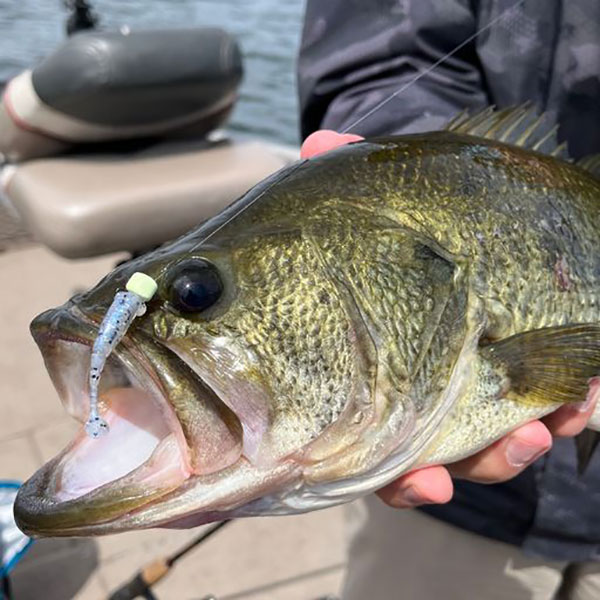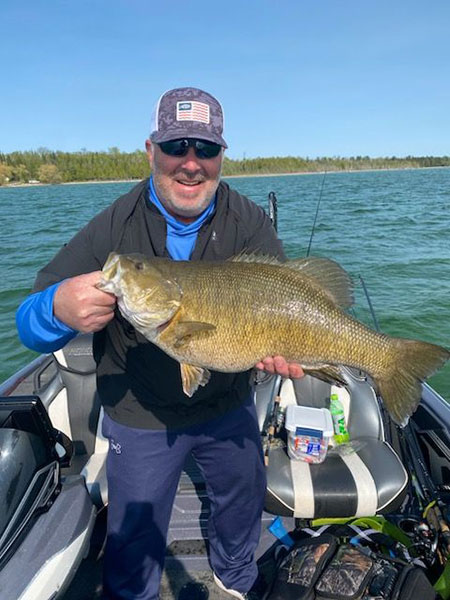- Details
Z-Man Report
 Micro bait
Micro bait
Ever wondered why, year after year, some your biggest bass seem to chomp the smallest lures you throw? Why those big old largemouths won’t leave you alone when all you want to do is catch crappies? And why, even when the water’s cold or the bite’s completely off, smallmouth bass continue munching those tiny little baits with aggression?
Every season, but especially in the coolwater periods of winter and spring, microbaits from 1- to 3-inches deliver consistent if not occasionally spectacular bass bites. And as you’ve probably already discovered—although you’ll catch plenty of smaller fish—some of the bass will be those 3- to 5-pound footballs.
When Bass Bite Small Stuff
Turns out, bass of all sizes feed on small stuff—invertebrates like baby crayfish, insect larvae and tiny minnows—much more often than we realize. One study1 of largemouth bass diets, for example, revealed that among a sample size of 43 adult bass, 30 of their stomachs contained invertebrates (insects and larvae), while only 19 contained fish; or 257 total invertebrates versus 118 fish. A separate study of smallmouth bass2 found that among 95 bass stomachs containing food, 58 contained small crayfish, while only 13 held fish.
Unquestionably, while bass of both species derive greater caloric value and growth from a diet of larger baitfish, invertebrates and young fish (including bass fry) can sustain bass during coolwater periods, while heartier food is scarce. Late winter through spring is one phase when bass may key on colonies of freshwater invertebrates as a means of maintenance feeding, nourishing themselves until baitfish begin to hatch. Invertebrates such as mayfly and midge larvae and aquatic worms known as oligochaetes can all figure prominently into bass feeding. As summer approaches, newly hatched clouds of baby gamefish, shad, shiners and bullheads enliven the menu.
Matching Movement Over Shape
As predatory opportunists, bass eat them all. And yet, while matching prevailing hatches with lifelike lures can appeal visually to bass—particularly in clear water and especially for smallmouth bass—angling success often stems from lively lure movements rather than body shape alone. In short, a generalist forage profile and silhouette, such as a black Micro TRD™, marabou jig or a green pumpkin Tiny TicklerZ™ will induce bites in almost any environment.
- Details
By Al McGuckin
 Mike Iaconelli
Mike Iaconelli
Team Toyota’s Mike Iaconelli began his competitive fishing career in the early 1990s on the Delaware River where catching a 9-pound limit made you look like a superstar.
So, the recent stinginess “Ike” and other pros encountered at Lay Lake, and what is sure to be a brutally tough Sabine River at the upcoming Elite Series event in Orange, Texas, are the sort of tests he’s been preparing for and passing most of his fishing life.
“We’ve been on the Sabine during the spawn, and a 12-pound limit was great. How tough is that place going to be when we get there next week in the heat of early summer?” ponders Iaconelli.
The Sabine is sure to be the toughest test of the 2023 Bassmaster Elite Series season, and Iaconelli says the same three lures that carried him through Lay Lake to sit 7th in the Angler of the Year standings will also be in play at the Sabine.
- Details
By Louie Stout
 Todd Vydick with his big smallmouth
Todd Vydick with his big smallmouth
Todd Vydick’s primary hope was to improve his personal best when he hired Cody Johnson to guide him for big smallmouth in the Traverse City, Mich. area.
“My biggest bass up to that point was 6.1 pounds,” said Vydick of Hartland, Mich. “I try to improve my personal best every time I fish with Todd.”
Well, mission accomplished – and in spades. Vydick not only bettered his biggest when he landed a 9.3-pound smallmouth, but also came up about a half pound shy of tying the Michigan record.
They fished into the evening last Monday when they encountered a school of smallmouth holding on a small grass patch in about 20 feet of water.
The Brighton, Mich. guide said he spotted the school along a drop-off on his Humminbird Side Imaging unit. He doesn’t have forward-facing sonar.
That’s where the behemoth bass ate Todd’s ¼-ounce, green pumpkin Strike King coffee tube. He knew it was big, but had no idea it was that big.





